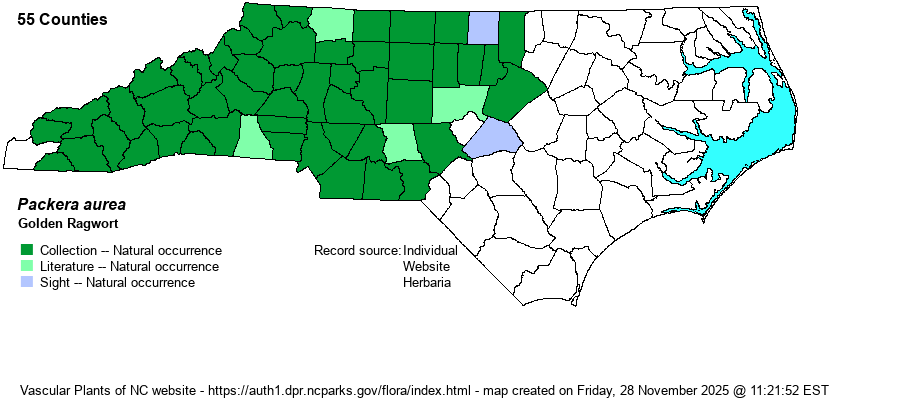| Author | (L.) A. Love & D. Love | |
| Distribution | Mountains and Piedmont; absent from the Sandhills proper and the remainder of the Coastal Plain. Amazingly, this species is found in all southeastern VA counties, yet it has not yet been found in a single county in the NC Coastal Plain!
Lab. to Man., south to northern FL and OK. Generally absent on the Coastal Plain south of VA. | |
| Abundance | Frequent to common, and can be locally abundant, across the Mountains and most of the Piedmont; rare to uncommon in the northeastern Piedmont, with no records yet east of Granville and Wake counties. Can occur in very dense patches of hundreds to thousands of plants. | |
| Habitat | Wet to perennially moist soils of streamheads, creek margins, swamp forests, bottomlands, and montane seepage slopes. | |
| Phenology | Flowering and fruiting late March - early June. | |
| Identification | Unlike most of our ragworts, Golden Ragwort has heart-shaped basal leaves (not narrowly elliptical or dissected) on long stalks. Stem leaves, however, are narrowly elliptical and dissected, with a rather cordate tip. Only Serpentine Ragwort (P. serpenticola) has similarly cordate basal leaves, but they are densely tomentose (vs. glabrous). The flowers are similar to others in the genus, with numerous heads that are golden-yellow in color. A large stand in a bottomland or swampy area when in bloom can turn the herb layer a bright golden color! | |
| Taxonomic Comments | Formerly Senecio aureus.
| |
| Other Common Name(s) | Golden Groundsel | |
| State Rank | S5 | |
| Global Rank | G5 | |
| State Status | | |
| US Status | | |
| USACE-agcp | FACW link |
| USACE-emp | FACW link |

